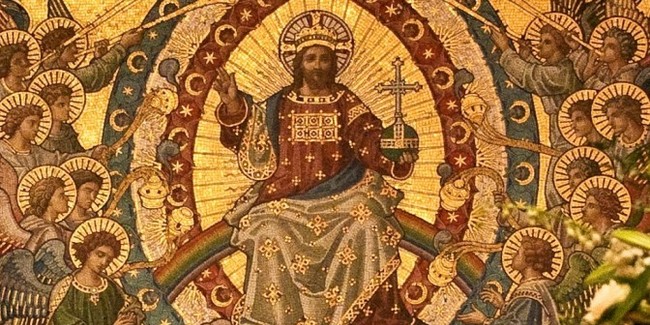“These [the kings of the world] are united in yielding their power and authority to the beast; they will make war on the Lamb, and the Lamb will conquer them, for he is Lord of lords and King of kings, and those with him are called and chosen and faithful” (Revelation 17:13–14 NRSV).

It seems our Lord even has a tattoo on his thigh and a monogram on his robe. In Revelation 19:16 we read: “On his robe and on his thigh he has a name inscribed, ‘King of kings and Lord of lords'” (NRSV).
Since 1925 the Roman Catholic Church has celebrated the Feast of Christ the King, and in 1970 it was moved to the last Sunday before the beginning of Advent. This year it will be November 25. The feast has the highest rank of solemnity. This feast is also celebrated by the Anglican communion and many mainline Protestant denominations.
Back on October 7, a young blogger from the Diocese of Broken Bay (Australia) tweeted: “Most people want Jesus as a consultant rather than a king.” The archbishop of Brisbane, Mark Coleridge, responded to him saying: “Not too sure I want (or have) him as either.” Many have made much of his tweet. Many have asked for clarification. Then he wrote a few days later:
I worship Jesus reigning from the Cross, whose “kingdom is not of this world” and who “casts the mighty from their thrones”…I don’t favour royalist ideologies “of this world” which make Christ remote, the Church triumphalist, the Pope and bishops princely etc. (Tweet on October 10).
Twitter is probably not the best place to lay out your theology, even though now you have 240 characters instead of 120 to make your point. I don’t in any way pretend to know what Archbishop Coleridge means by his first or second tweet. Yet it does raise some concerns, not the tweet alone, but the other comments that this prelate has made in these times of fuzzy theology.
Back in 2015, after the Synod on the Family, Coleridge took exception to several phrases that are common and current in the Catholic Church and suggested that should be rethought:
- The “indissolubility” of marriage
“Keeping Church teaching intact can still open up a vast field of pastoral creativity…. Our danger, and not just the bishops but others in the Church, is to think that we’re condemned to dance in chains unless we can change the Church’s teaching.” (Crux) - The “intrinsically disordered” nature of homosexual acts
In the case of the Church calling homosexual acts “intrinsically disordered” and homosexuality itself “objectively disordered,” for instance, he said that way of putting things leads to a “sense of alienation.” “Can the synod find a language that is in fact positive, less alienating, less excluding?” (Crux) - Calling divorce and civil remarriage “adultery”
As for adultery, Coleridge argued that “to say that every divorce and remarriage situation is adulterous is perhaps too sweeping.” (Crux) He has also argued that using the word “adultery” for remarried divorcees needs to end. (LifeSite) - The old maxim of “love the sinner but hate the sin.”
He stated that the Catholic saying “love the sinner, hate the sin” with reference to homosexuality no longer holds since the distinction “no longer communicates” “in the real world” where sexuality is “part of [your] entire being.” (LifeSite)
Heading back to the kingship of Christ,Cardinal Raymond Burke said the following to the Rome Life Forum: “Catholics must consciously place themselves under the ‘Kingship of Christ’ in the face of enemies of the Church today attempting to ‘infiltrate the life of the Church herself and to corrupt the Bride of Christ by an apostasy from the Apostolic Faith’.” (May 2018) He added, “Christ as King reigns over his Bride the Church, over the world, and must also reign over human hearts.”
I find myself brought up short when I pose the question to myself: “Do I recognize Christ as King over the Church, the world and my heart?” if I answer in the negative. I have to do a systems check against Colossians 1:15–23, as does every bishop, priest and layperson in the Church.
He is the image of the invisible God, the firstborn of all creation; for in him all things in heaven and on earth were created, things visible and invisible, whether thrones or dominions or rulers or powers—all things have been created through him and for him. He himself is before all things, and in him all things hold together. He is the head of the body, the church; he is the beginning, the firstborn from the dead, so that he might come to have first place in everything. For in him all the fullness of God was pleased to dwell, and through him God was pleased to reconcile to himself all things, whether on earth or in heaven, by making peace through the blood of his cross.
And you who were once estranged and hostile in mind, doing evil deeds, he has now reconciled in his fleshly body through death, so as to present you holy and blameless and irreproachable before him— provided that you continue securely established and steadfast in the faith, without shifting from the hope promised by the gospel that you heard, which has been proclaimed to every creature under heaven. I, Paul, became a servant of this gospel.
Christ is King! Christ is Lord! And if you, I, or anyone cannot express that with confidence, we have to ask, “Who is lord in His place?”